mobile View, to the German Version tap the flag


- 1804–1867
- Empire of Austria (Austrian Empire)
• Flags
• Meaning/Origin of the Flag
• Coat of Arms
• Meaning/Origin of the Coat of Arms
Further Austria pages (historical Flags and Coats of Arms):
• Empire of the Austrian Habsburgs (to 1804)
• Austria-Hungary (1867–1918)
• Republic of Austria (since 1918)

1804–1867,
Flag of the country (Colours of the country),
Source, by: Flags of the World



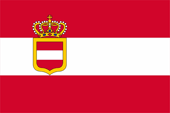
1804–1867,
Naval und War flag,
Source, by: austria-forum.org,
zeljko-heimer-fame.from.hr



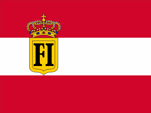
1804–1867,
Merchant flag,
Variant,
Source, by: zeljko-heimer-fame.from.hr



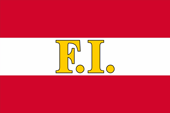
Merchant flag,
Variant,
Source, by: zeljko-heimer-fame.from.hr



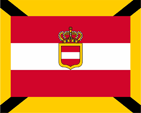
ca. 1840–1869,
Pilot flag (signal for a pilot),
Source, by: Deppermann, Ruschke, Flaggen-Almanach, Hamburg, 1844, via
zeljko-heimer-fame.from.hr




1848–1852,
Flag of the German Confederation,
Source, by: Die Welt der Flaggen





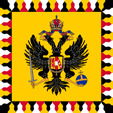
1828–1867,
Flag of the Emperor,
Source, by: zeljko-heimer-fame.from.hr





The flags used in the Habsburg's domain often showed the colors black and gold and a double-headed eagle. These are the colors of the German Empire (actually the Holy Roman Empire of German Nation), whose emperor came out of the dynasty of the Habsburgs from 1438 to 1806. The coat of arms of the empire showed from 1433 a black, double-headed eagle on gold, from which the colors are derived. Thus the eagle is the symbol of the empire, even if it is nowadays sometimes called "Habsburg Eagle". The Habsburgs heraldry is actually different. Originally a red, blue armored lion on gold. The Austrian band-shield, which originally came from the Babenberg dynasty was added later, to clearly identify the Habsburgs as the "House of Austria". The marriage of Maria Theresia and Franz Stephan von Lothringen in 1736 created the line of Habsburg-Lorraine. The German Empire, which existed until 1806, was an electoral monarchy, so the dignity of the emperor was not hereditary. Nevertheless, out of the House of Habsburg the German emperors came for centuries. The heraldry of the German Empire and the colors black and gold were transferred to the House of Habsburg, so that flags in these colors were used throughout their domain. It is important to note that the heraldry and colors passed from the German Empire to the House of Habsburg and not vice versa. For the monarch's personal flag, this means that it must have been the flag of the empire. A "Habsburg Empire" was not defined. There was only the elected Emperor of the German Empire from the House of Habsburg with his own property, in form of his own inheritance. In this way is the transfer of Habsburg heraldry into symbols of the German Empire not appropriate and unlikely. Nevertheless, dubious images of the imperial eagle with the Habsburg house-crown above them can be found as symbols of the German Empire. Flags in the original have not survived from this time, only vague descriptions that can be incorrect. For some hereditary lands, what means the direct domain of the Habsburgs, this phenomenon occurs. In 1686, for example, the golden flag with the two-headed eagle was officially introduced as the flag for the Habsburg domain. This was also maintained when the German Empire went under in 1806 and Austria (already in 1804) had been defined as a separate state. Even when a new German Empire was founded in 1871, which at least used a black eagle on gold in the coat of arms.
The the eagle-flag was allowed to use the flag by private persons in the sense of a merchant flag until 1749. But that flag was difficultly to produce and thats why arised already about 1730 flags with two stripes in the colours black and gold. In this way became the device of the black eagle on golden ground abridged heraldical: black over gold. Since the establishment of the Empire of Austria in 1804 it was allowed to use this flag as national flag. Some sources (historical lexicons, historical atlases or catalogs) show the eagle-flag as a kind of state symbol for the states of the Habsburg monarchy: Austrian Empire and Austria-Hungary. However, the real existence of such a flag cannot be proven.
Emperor Joseph II then broke with the black and gold continuity and on 20th of March in 1786 he introduced the first truly Austrian flag for use at sea. It showed the picture of the Austrian band-shield, three horizontal stripes in red, white and red and in the middle, shifted towards the mast, the golden banded band-shield with a stylized royal crown above it.
The Navy kept this flag, while merchant ships used a similar variant. As merchant flag was used the red, white and red base-cloth, but without the band-shield coat of arms. Instead, there was a crowned golden escutcheon with the letters F and I in it. Many variants of these flags are reported, for example: a red-white-red flag, in its white stripes placed the letters F and I, or, the naval flag, but in the white stripe of the band-shield coat of arms added the letters F and I. It can be assumed that these variants were made on a private initiative, because the correct flag may not have been available. The letters F and I could have been something like the initials of the emperor, for example Ferdinand I. (1835-1848) or Franz I. (1804-1835), because there were also variants that showed F J what could stand for Franz Joseph (1848-1916). There was also the combination F I I, what could stand for Franz II. (as Franz II. from 1792 to 1806 Emperor of the Holy Roman Empire of German Nation and as Franz I. from 1804 to 1835 Emperor of Austria).
The emperor also received a personal flag in 1828. It was square, single-coloured golden with an edge of triangles in black, gold, red and white, the colours of Austria. In the middle of the flag was placed the double-eagle with the coat of arms of the dynasty of Habsburg-Lorraine on the chest.
In context with the revolution of 1848 became the black-red-golden flag in Austria popular too. It was the symbol of the new beginning in the sense of a Great German solution of the German Question. On this occasion arised the Austrian troops in the year 1864 in the war of the German Confederation against Denmark under this flag on the battleground.
Source: austria-forum.org,
zeljko-heimer-fame.from.hr,
Flags of the World,
Volker Preuß



since 1736,
Coat of arms of the line of Habsburg-Lorraine (Habsburg-Lothringen),
Source, by: Wikipedia (D)
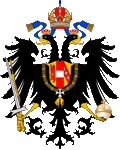
1836–1915,
Empire of Austria, lesser coat of arms,
Source, by: Flags of the World
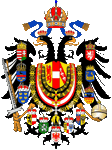
1866–1915,
Empire of Austria, middle coat of arms,
Source, by: Wikipedia (D)

The House of Habsburg divided in 1556 in a Spanish and in an Austrian line.
Both lines used the black double-headed eagle of the Holy Roman Empire of German Nation (Old German Empire, First Empire) for centuries. The Habsburgs heraldry is actually different. Originally a red, blue armored lion on gold. The Austrian band-shield, which originally came from the Babenberg dynasty was added later, to clearly identify the Habsburgs as the "House of Austria". The marriage of Maria Theresia and Franz Stephan von Lothringen in 1736 created the line of Habsburg-Lorraine. The coat of arms of Lorraine shows a golden shield, topped with a red slant right bar, which is in further topped with three silvery Alerions. The coat of arms of the dynasty of Habsburg-Lorraine – as a combination of the heraldry of Habsburg, Babenberg and Lorraine – was placed on the eagle from time to time when only the Habsburg hereditary lands were to be represented, sometimes only the red-white-red band-shield.
In the year 1836 was created a new coat of arms for the Austrian line of the Habsburg monarchy and finally renewed in 1866. It showed as lesser coat of arms a threefold crowned twin-headed eagle with the Habsburg-Lothringian coat of arms as chest or heart shield. The chest-shield was surrounded by the collane of the Order of the Golden Fleece. In the catches the eagle held sword, scepter and the imperial orb.
The middle coat of arms showed a threefold crowned twin-headed eagle with the Habsburg-Lothringian coat of arms as chest or heart shield. On the chest shield hung the three highest merit orders. Around the chest-shield are arranged crowned shields with the coats of arms of the crown lands. The chest-shield was surrounded by the collane of the Order of the Golden Fleece. Those changed sometimes in the years ever by the number of the crown lands, at least in 1866. In the catches held the eagle sword, scepter and the imperial orb.
Source: Flags of the World,
Wikipedia (D),
Volker Preuß

look Austria

![]()


























